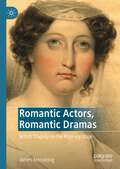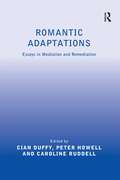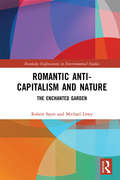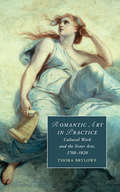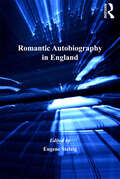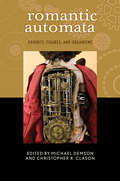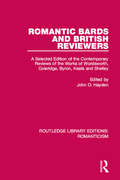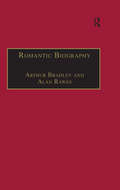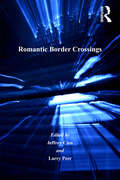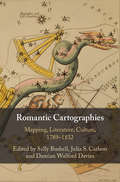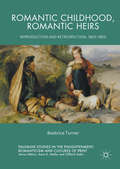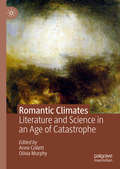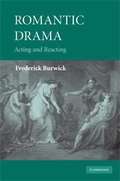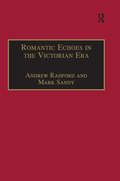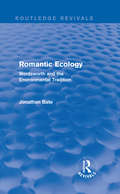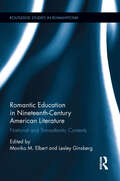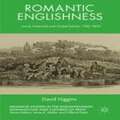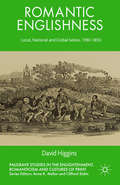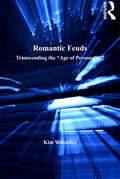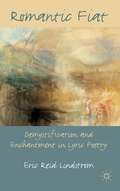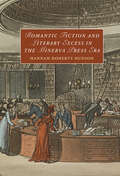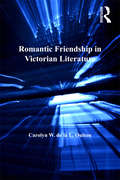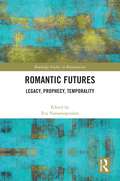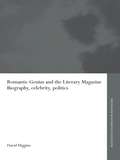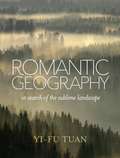- Table View
- List View
Romantic Actors, Romantic Dramas: British Tragedy on the Regency Stage
by James ArmstrongThis book reinterprets British dramas of the early-nineteenth century through the lens of the star actors for whom they were written. Unlike most playwrights of previous generations, the writers of British Romantic dramas generally did not work in the theatre themselves. However, they closely followed the careers of star performers. Even when they did not directly know actors, they had what media theorists have dubbed "para-social interactions" with those stars, interacting with them through the mediation of mass communication, whether as audience members, newspaper and memoir readers, or consumers of prints, porcelain miniatures, and other manifestations of "fan" culture. This study takes an in-depth look at four pairs of performers and playwrights: Sarah Siddons and Joanna Baillie, Julia Glover and Samuel Taylor Coleridge, Edmund Kean and Lord Byron, and Eliza O'Neill and Percy Bysshe Shelley. These charismatic performers, knowingly or not, helped to guide the development of a character-based theatre—from the emotion-dominated plays made popular by Baillie to the pinnacle of Romantic drama under Shelley. They shepherded in a new style of writing that had verbal sophistication and engaged meaningfully with the moral issues of the day. They helped to create not just new modes of acting, but new ways of writing that could make use of their extraordinary talents.
Romantic Adaptations: Essays in Mediation and Remediation
by Peter Howell Cian DuffyHow did romanticism define its relationship with its sources? How has romanticism since been understood and misunderstood across a range of cultural activities? These are among the questions taken up in this reexamination of the place of adaptation within romanticism. Renegotiating the cultural topography of the period and the place of romanticism in subsequent cultural history, the volume focuses on the adaptation of source material by romantic writers and the adaptation in subsequent periods of the tropes and ideologies associated with romanticism. In place of a hierarchical distinction between source and text, between ’romanticism’ and its contexts, the collection identifies distinct but overlapping and mutually constitutive genres such as the Gothic and romance. Whether their essays deal with early nineteenth-century periodical reviews, affordable editions of Pride and Prejudice aimed at the late nineteenth-century mass audience, or the ongoing cultural presence of romanticism in late twentieth- and early twenty-first-century debates about embryology and stem cell research, the contributors remain cognizant of the tension between the processes of adaptation and the apparent ideology of romantic originality.
Romantic Anti-capitalism and Nature: The Enchanted Garden (Routledge Explorations in Environmental Studies)
by Michael Löwy Robert SayreRomantic Anti-capitalism and Nature examines the deep connections between the romantic rebellion against modernity and ecological concern with modern threats to nature. The chapters deal with expressions of romantic culture from a wide variety of different areas: travel writing, painting, utopian vision, cultural studies, political philosophy, and activist socio-political writing. The authors discuss a highly diverse group of figures - William Bartram, Thomas Cole, William Morris, Walter Benjamin, Raymond Williams, and Naomi Klein - from the late eighteenth to the early twenty-first century. They are rooted individually in English, American, and German cultures, but share a common perspective: the romantic protest against modern bourgeois civilisation and its destruction of the natural environment. Although a rich ecocritical literature has developed since the 1990s, particularly in the United States and Britain, that addresses many aspects of ecology and its intersection with romanticism, they almost exclusively focus on literature, and define romanticism as a limited literary period of the late eighteenth and early nineteenth centuries. This study is one of the first to suggest a much broader view of the romantic relation to ecological discourse and representation, covering a range of cultural creations and viewing romanticism as a cultural critique, or protest against capitalist-industrialist modernity in the name of past, pre-modern, or pre-capitalist values. This book will be of great interest to students and scholars of ecology, romanticism, and the history of capitalism.
Romantic Art in Practice: Cultural Work and the Sister Arts, 1760–1820 (Cambridge Studies in Romanticism #122)
by Thora BryloweExploring the relationship between visual art and literature in the Romantic period, this book makes a claim for a sister-arts 'moment' when the relationship between painting, sculpture, pottery and poetry held special potential for visual artists, engravers and artisans. Elaborating these cultural tensions and associations through a number of case studies, Thora Brylowe sheds light on often untold narratives of English labouring craftsmen and artists as they translated the literary into the visual. Brylowe investigates examples from across the visual spectrum including artefacts, such as Wedgwood's Portland Vase, antiquarianism through the work of William Blake, the career of engraver John Landseer, and the growing influence of libraries and galleries in the period, particularly Boydell's Shakespeare Gallery. Brylowe artfully traces the shifting cultural connections between the imaginative word and the image in a period that saw new print technologies deluge Britain with its first mass media.
Romantic Autobiography in England (The\nineteenth Century Ser.)
by Eugene StelzigTaking into account the popularity and variety of the genre, this collaborative volume considers a wide range of English Romantic autobiographical writers and modes, including working-class autobiography, the familiar essay, and the staged presence. In the wake of Rousseau's Confessions, autobiography became an increasingly popular as well as a literary mode of writing. By the early nineteenth century, this hybrid and metamorphic genre is found everywhere in English letters, in prose and poetry by men and women of all classes. As such, it resists attempts to provide a coherent historical account or establish a neat theoretical paradigm. The contributors to Romantic Autobiography in England embrace the challenge, focusing not only on major writers such as William Wordsworth, De Quincey, and Mary Shelley, but on more recent additions to the canon such as Mary Robinson, Dorothy Wordsworth, and Mary Hays. There are also essays on the scandalous Memoirs of Mrs. Billington and on Joseph Severn's autobiographical scripting of himself as "the friend of Keats." The result is an exploratory and provisional mapping of the field, provocative rather than exhaustive, intended to inspire future scholarship and teaching.
Romantic Automata: Exhibitions, Figures, Organisms (Transits: Literature, Thought & Culture 1650-1850)
by Frederick Burwick Kathryn S. Freeman Erin M. Goss Ashley Shams Peter Erickson Wendy C. Nielsen Kate Singer Stefani Engelstein Lenora Hanson Christina Maria WeilerFor most of the eighteenth century, automata were deemed a celebration of human ingenuity, feats of science and reason. Among the Romantics, however, they prompted a contradictory apprehension about mechanization and contrivance: such science and engineering threatened the spiritual nature of life, the source of compassion in human society. A deep dread of puppets and the machinery that propels them consequently surfaced in late eighteenth and early nineteenth century literature. Romantic Automata is a collection of essays examining the rise of this cultural suspicion of mechanical imitations of life. Recent scholarship in post-humanism, post-colonialism, disability studies, post-modern feminism, eco-criticism, and radical Orientalism has significantly affected the critical discourse on this topic. In engaging with the work and thought of Coleridge, Poe, Hoffmann, Mary Shelley, and other Romantic luminaries, the contributors to this collection open new methodological approaches to understanding human interaction with technology that strives to simulate, supplement, or supplant organic life. Published by Bucknell University Press. Distributed worldwide by Rutgers University Press.
Romantic Bards and British Reviewers: A Selected Edition of Contemporary Reviews of the Works of Wordsworth, Coleridge, Byron, Keats and Shelley (Routledge Library Editions: Romanticism #14)
by John O. HaydenFirst published in 1971. This collection of contemporary reviews of the five major English Romantic poets – Wordsworth, Coleridge, Byron, Keats and Shelley – makes available the critical documents of a great period of literature and literary reviewing. Professor Hayden has selected sixty-eight reviews in which twenty-six periodicals are represented, ranging from the powerful quarterlies and the monthly reviews to the newly established weeklies and the fashionable ladies’ magazines. The reviews give an insight into the Romantic period in England, its literature, critical values, and general interests. This title includes annotations to explain allusions to contemporary events and persons and to translate foreign words and phrases. This title will be of great interest to students of English literature.
Romantic Biography (The Nineteenth Century Series)
by Arthur BradleyRomantic biography lives. Despite the so-called 'death of the author', popular interest in the lives of the major Romantic writers has reached a new peak. Romantic Biography brings together Romantic biographers and critics to consider some of the key questions surrounding this publishing phenomenon. What precisely is Romantic biography? What is the relationship between it and Romantic writings more generally? And to what extent is Romantic biography itself the product of Romantic ideas about the self, time and creativity? Romantic Biography examines a range of canonical and non-canonical biographical subjects from a variety of practical and theoretical standpoints. Michael O'Neill opens the collection with an analysis of the relationship between Romantic biography and Romantic poetry. Jonathan Bate, Mark Storey and Kenneth R. Johnston reassess Clare, Southey and Wordsworth from their position as authors of recent/forthcoming biographies of the poets. Joe Bray and Alan Rawes explore the Romantic assumptions at work within contemporary biographies of Austen and Byron. Gerard Carruthers, Julian North, Jennifer Wallace and Arthur Bradley put biographies of Burns, Scott, Coleridge, Byron, Keats and Shelley into the context of contemporary historicist and theoretical ideas about national and gender identity, the body and difference. Ralph Pite brings the collection to a close with a further examination of the vexed question of Romantic biography's relation to Romanticism itself. Romantic Biography is a major new survey of Romantic life-writing and an important contribution to biographical studies more generally.
Romantic Border Crossings (The\nineteenth Century Ser.)
by Larry PeerRomantic Border Crossings participates in the important movement towards 'otherness' in Romanticism, by uncovering the intellectual and disciplinary anxieties that surround comparative studies of British, American, and European literature and culture. As this diverse group of essays demonstrates, we can now speak of a global Romanticism that encompasses emerging critical categories such as Romantic pedagogy, transatlantic studies, and transnationalism, with the result that 'new' works by writers marginalized by class, gender, race, or geography are invited into the canon at the same time that fresh readings of traditional texts emerge. Exemplifying these developments, the authors and topics examined include Elizabeth Inchbald, Lord Byron, Gérard de Nerval, English Jacobinism, Goethe, the Gothic, Orientalism, Emily Dickinson, Walt Whitman, Anglo-American conflicts, manifest destiny, and teaching romanticism. The collection constitutes a powerful rethinking of the divisions that continue to haunt Romantic studies.
Romantic Cartographies: Mapping, Literature, Culture, 1789–1832
by Julia S. Carlson Damian Walford Davies Sally BushellRomantic Cartographies is the first collection to explore the reach and significance of cartographic practice in Romantic-period culture. Revealing the diverse ways in which the period sought to map and spatialise itself, the volume also considers the engagement of our own digital cultures with Romanticism's 'map-mindedness'. Original, exploratory essays engage with a wide range of cartographic projects, objects and experiences in Britain, and globally. Subjects range from Wordsworth, Clare and Walter Scott, to Romantic board games and geographical primers, to reveal the pervasiveness of the cartographic imagination in private and public spheres. Bringing together literary analysis, creative practice, geography, cartography, history, politics and contemporary technologies – just as the cartographic enterprise did in the Romantic period itself – Romantic Cartographies enriches our understanding of what it means to 'map' literature and culture.
Romantic Childhood, Romantic Heirs
by Beatrice TurnerThis book views Romantic literature's discourses of childhood, education, and reproduction through the eyes of four early nineteenth-century British authors who were uniquely implicated in those discourses. Hartley and Sara Coleridge, children of Samuel Taylor Coleridge, and Mary Wollstonecraft Shelley and William Godwin Jr, children of William Godwin, shared the predicament of being both 'real' and 'literary' children. All the children of authors who helped shape culturally-definitive Romantic-period ideas about childhood, they wrote back to their fathers in order to understand and to resist the ways in which they were produced by paternal texts which foreclose the possibility of the child's own regeneration. This study proposes that through this predicament, and their responses to it, the literature of the period between the Romantic and the Victorian periods comes into focus, marked by an anxiety not of influence, but of reproduction. It suggests that one reason why this period has tended to disappear from view lies in the sense of historical and aesthetic difference, and productive failure, which this study uncovers.
Romantic Climates: Literature and Science in an Age of Catastrophe
by Anne Collett Olivia MurphyThis book seeks to uncover how today’s ideas about climate and catastrophe have been formed by the thinking of Romantic poets, novelists and scientists, and how these same ideas might once more be harnessed to assist us in the new climate challenges facing us in the present. The global climate disaster following Mt Tambora’s eruption in 1815 – the ‘Year without a Summer’ – is a starting point from which to reconsider both how the Romantics responded to the changing climates of their day, and to think about how these climatic events shaped the development of Romanticism itself. As the contributions to this volume demonstrate, climate is an inescapable aspect of Romantic writing and thinking. Ideologies and experiences of climate inform everything from scientific writing to lyric poetry and novels. The ‘Diodati circle’ that assembled in Geneva in 1816 – Lord Byron, Percy and Mary Shelley, John Polidori and John Cam Hobhouse and the gothic novelist MG ‘Monk’ Lewis – is synonymous with the literature of that dreary, uncanny season. Essays in this collection also consider the work of Jane Austen, John Keats and William Wordsworth, along with less well-known figures such as the scientist Luke Howard, and later responses to Romantic climates by John Ruskin and Virginia Woolf.
Romantic Drama: Acting and Reacting
by Frederick BurwickDrama in the Romantic period underwent radical changes affecting theatre performance, acting, and audience. Theatres were rebuilt and expanded to accommodate larger audiences, and consequently acting styles and the plays themselves evolved to meet the expectations of the new audiences. This book examines manifestations of change in acting, stage design, setting, and the new forms of drama. Actors exercised a persistent habit of stepping out of their roles, whether scripted or not. Burwick traces the radical shifts in acting style from Garrick to Kemble and Siddons, and to Kean and Macready, adding a new dimension to understanding the shift in cultural sensibility from early to later Romantic literature. Eye-witness accounts by theatre-goers and critics attending plays at the major playhouses of London, the provinces, and on the Continent are provided, allowing readers to identify with the experience of being in the theatre during this tumultuous period.
Romantic Echoes in the Victorian Era (The Nineteenth Century Series)
by Andrew RadfordIn tracing those deliberate and accidental Romantic echoes that reverberate through the Victorian age into the beginning of the twentieth century, this collection acknowledges that the Victorians decided for themselves how to define what is 'Romantic'. The essays explore the extent to which Victorianism can be distinguished from its Romantic precursors, or whether it is possible to conceive of Romanticism without the influence of these Victorian definitions. Romantic Echoes in the Victorian Era reassesses Romantic literature's immediate cultural and literary legacy in the late nineteenth century, showing how the Victorian writings of Matthew Arnold, Wilkie Collins, the Brontës, the Brownings, Elizabeth Gaskell, Charles Dickens, Gerard Manley Hopkins, Thomas Hardy, and the Rossettis were instrumental in shaping Romanticism as a cultural phenomenon. Many of these Victorian writers found in the biographical, literary, and historical models of Chatterton, Coleridge, Byron, Shelley, Keats, and Wordsworth touchstones for reappraising their own creative potential and artistic identity. Whether the Victorians affirmed or revolted against the Romanticism of their early years, their attitudes towards Romantic values enriched and intensified the personal, creative, and social dilemmas described in their art. Taken together, the essays in this collection reflect on current critical dialogues about literary periodisation and contribute to our understanding of how these contemporary debates stem from Romanticism's inception in the Victorian age.
Romantic Ecology: Wordsworth and the Environmental Tradition (Routledge Revivals)
by Jonathan BateFirst published in 1991, Romantic Ecology reassesses the poetry of William Wordsworth in the context of the abiding pastoral tradition in English Literature. Jonathan Bate explores the politics of poetry and argues that contrary to critics who suggest that the Wordsworth was a reactionary who failed to represent the harsh economic reality of his native Lake District, the poet’s politics were fundamentally ‘green’. As our first truly ecological poet, Wordsworth articulated a powerful and enduring vision of human integration with nature which exercised a formative influence on later conservation movements and is of immediate relevance to great environmental issues today. Challenging the orthodoxies of new historicist criticism, Jonathan Bate sets a new agenda for the study of Romanticism in the 1990s.
Romantic Education in Nineteenth-Century American Literature: National and Transatlantic Contexts (Routledge Studies in Romanticism)
by Monika M Elbert Lesley GinsbergAmerican publishing in the long nineteenth century was flooded with readers, primers, teaching-training manuals, children’s literature, and popular periodicals aimed at families. These publications attest to an abiding faith in the power of pedagogy that has its roots in transatlantic Romantic conceptions of pedagogy and literacy. The essays in this collection examine the on-going influence of Romanticism in the long nineteenth century on American thinking about education, as depicted in literary texts, in historical accounts of classroom dynamics, or in pedagogical treatises. They also point out that though this influence was generally progressive, the benefits of this social change did not reach many parts of American society. This book is therefore an important reference for scholars of Romantic studies, American studies, historical pedagogy and education.
Romantic Englishness
by David HigginsRomantic Englishness investigates how narratives of localised selfhood in English Romantic writing are produced in relation to national and transnational formations. This book focuses on autobiographical texts by authors such as John Clare, Samuel Taylor Coleridge, William Hazlitt, Charles Lamb, and William Wordsworth.
Romantic Englishness: Local, National and Global Selves, 1780-1850 (Palgrave Studies in the Enlightenment, Romanticism and Cultures of Print)
by D. HigginsRomantic Englishness investigates how narratives of localised selfhood in English Romantic writing are produced in relation to national and transnational formations. This book focuses on autobiographical texts by authors such as John Clare, Samuel Taylor Coleridge, William Hazlitt, Charles Lamb, and William Wordsworth.
Romantic Feuds: Transcending the 'Age of Personality' (The Nineteenth Century Series)
by Kim WheatleyRomantic writers such as Robert Southey and Samuel Taylor Coleridge aspired to rise above the so-called 'age of personality,' a new culture of politicized print gossip and personal attacks. Nevertheless, Southey, Coleridge, and other Romantic-era figures such as Leigh Hunt, William Hazlitt, Sydney Owenson, and the explorer John Ross became enmeshed in lively feuds with the major periodicals of the day, the Edinburgh Review and the Quarterly Review. Kim Wheatley focuses on feuds from the second and third decades of the nineteenth century, suggesting that by this time the vituperative rhetoric of the Edinburgh and the Quarterly had developed into what Coleridge called 'a habit of malignity.' Attending to the formal strategies of the reviewers' surprisingly creative prose, she traces how her chosen feuds take on lives of their own, branching off into other print media, including the weekly press and monthly magazines. Ultimately, Wheatley shows, these hostile exchanges incorporated literary genres and Romantic themes such as the idealized poetic self, the power of the supernatural, and the quest for the sublime. By turning episodes of print warfare into stories of transfiguration, the feuds thus unexpectedly contributed to the emergence of Romanticism.
Romantic Fiat
by Eric Reid LindstromIn the Romantic period's economics of 'fiat' money the legacy of romanticism involves absolutist gestures of verbal fiat. Focused on William Wordsworth, but in constant range of his poet-successors and modern critics, Romantic Fiat presents an argument for a double romantic signature of 'let there be' and 'let be. '
Romantic Fiction and Literary Excess in the Minerva Press Era (Cambridge Studies in Romanticism #142)
by Hannah Doherty HudsonJane Austen's ironic reference to 'the trash with which the press now groans' is only one of innumerable Romantic complaints about fiction's newly overwhelming presence. This book draws on evidence from over one hundred Romantic novels to explore the changes in publishing, reviewing, reading, and writing that accompanied the unprecedented growth in novel publication during the Romantic period. With particular focus on the infamous Minerva Press, the most prolific fiction-producer of the age, Hannah Hudson puts its popular authors in dialogue with writers such as Walter Scott, Ann Radcliffe, Maria Edgeworth, and William Godwin. Using paratextual materials including reviews, advertisements, and authorial prefaces, this book establishes the ubiquity of Romantic anxieties about literary 'excess', showing how beliefs about fictional overproduction created new literary hierarchies. Ultimately, Hudson argues that this so-called excess was a driving force in fictional experimentation and the advertising and publication practices that shaped the genre's reception. This title is part of the Flip it Open Programme and may also be available Open Access. Check our website Cambridge Core for details.
Romantic Friendship in Victorian Literature (The\nineteenth Century Ser.)
by Carolyn W. OultonCarolyn Oulton recovers the strategies nineteenth-century authors used to justify the ideal of same-sex romantic friendship and the anxieties these strategies reveal. Informed by recent insights into the erotic potential of such relationships, but focused on romantic friendship as an independent and fully formulated ideal, Oulton departs from other critics who view romantic friendship as either nebulous and culturally naive or an invocation of homoerotic responsiveness. By considering both male and female friendships, Oulton uncovers surprising parallels between them in novels and poetry by authors such as Dickens, Tennyson, Disraeli, Charlotte Brontë, and Braddon. Oulton also examines conduct manuals, periodicals, and religious treatises, tracing developments from mid-century to the fin de siècle, when romantic friendship first came under serious attack. Her book is a persuasive challenge to those who view mid-Victorian England, existing in a state of blissful pre-Freudian innocence, as unproblematically accommodating of passionate same-sex relationships.
Romantic Futures: Legacy, Prophecy, Temporality (Routledge Studies in Romanticism)
by Evy VarsamopoulouRomantic Futures is a collection which explores the significance of futurity in British Romanticism from a comparative perspective in three defining manifestations: the future as conscious legacy, by which is meant both influences or continuities and the (anticipations of) impact on the future; the future as revealed by prophecy, whether via religious figures or superstitions; and, a meditation on the temporality of the future, or the future as a concept. The book brings together a wide range of theoretical and disciplinary perspectives: from utopian studies, history, religion and cultural theory to future studies, neuroscience, video games and art history. Aiming to increase and diversify current critical engagement and highlight the contemporary relevance of the Romantics’ multivalent preoccupation with the future, this collection renews the dialogue between Romanticism and our critical relation to its contemporaneity, especially as it speaks to current understandings of the future in the sciences, arts and humanities.
Romantic Genius and the Literary Magazine: Biography, Celebrity, Politics (Routledge Studies in Romanticism #Vol. 6)
by David HigginsIn early nineteenth-century Britain, there was unprecedented interest in the subject of genius, as well as in the personalities and private lives of creative artists. This was also a period in which literary magazines were powerful arbiters of taste, helping to shape the ideological consciousness of their middle-class readers. Romantic Genius and the Literary Magazine considers how these magazines debated the nature of genius and how and why they constructed particular creative artists as geniuses. Romantic writers often imagined genius to be a force that transcended the realms of politics and economics. David Higgins, however, shows in this text that representations of genius played an important role in ideological and commercial conflicts within early nineteenth-century literary culture. Furthermore, Romantic Genius and the Literary Magazine bridges the gap between Romantic and Victorian literary history by considering the ways in which Romanticism was understood and sometimes challenged by writers in the 1830s. It not only discusses a wide range of canonical and non-canonical authors, but also examines the various structures in which these authors had to operate, making it an interesting and important book for anyone working on Romantic literature.
Romantic Geography
by Yi-Fu TuanGeography is useful, indeed necessary, to survival. Everyone must know where to find food, water, and a place of rest, and, in the modern world, all must make an effort to make the Earth--our home--habitable. But much present-day geography lacks drama, with its maps and statistics, descriptions and analysis, but no acts of chivalry, no sense of quest. Not long ago, however, geography was romantic. Heroic explorers ventured to forbidding environments--oceans, mountains, forests, caves, deserts, polar ice caps--to test their power of endurance for reasons they couldn't fully articulate. Why climb Everest? "Because it is there. " Yi-Fu Tuan has established a global reputation for deepening the field of geography by examining its moral, universal, philosophical, and poetic potentials and implications. In his twenty-second book, Romantic Geography, he continues to engage the wide-ranging ideas that have made him one of the most influential geographers of our time. In this elegant meditation, he considers the human tendency--stronger in some cultures than in others--to veer away from the middle ground of common sense to embrace the polarized values of light and darkness, high and low, chaos and form, mind and body. In so doing, venturesome humans can find salvation in geographies that cater not so much to survival needs (or even to good, comfortable living) as to the passionate and romantic aspirations of their nature. Romantic Geography is thus a paean to the human spirit, which can lift us to the heights but also plunge us into the abyss.
